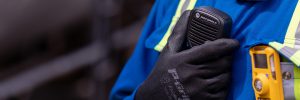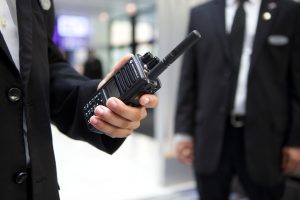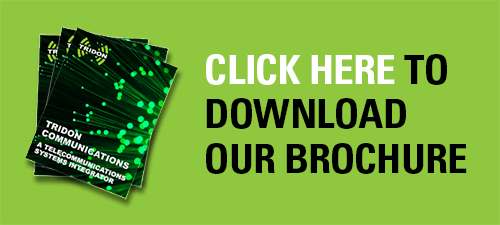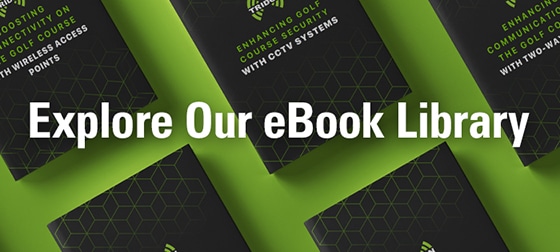Have questions about communicating safely?
Contact Us.
2020’s COVID-19 pandemic is forcing businesses to re-evaluate the way they operate, especially when it comes to communicating. Social distancing has gone from being a foreign term to everyday language in a matter of weeks, and the practice may continue for some time to come. That said, the need for communication in Alberta’s workplaces isn’t going away. That means new strategies will have to be found.
Email, smartphones, and video conferencing are all effective options that work well in office environments, but for businesses that require employees to constantly be on their feet and on the move, solutions like two-way radios are extremely effective. Their transmit range is more than enough to accommodate social distancing precautions and providing radios for each team member means they won’t have to share, mitigating the risk of sharing any germs.
For more information on how to stay safe during the COVID 19 pandemic, check with Alberta Health or Health Canada. For information on how to communicate effectively and safely, Contact Us, or keep reading.
Communicating Safely with Two-Way Radios
Industrial Environments
Clients working in the resource sector up near Fort McMurray have come to us looking for ways to utilize existing infrastructure to incorporate social distancing into their day-to-day communications. One example is the face to face meetings held at the start of a shift.
In a time where social distancing is quickly becoming the new norm, this simply isn’t possible if safety is going to be maintained. The challenges are only compounded by the fact that many of these clients work, and conduct these face to face meetings, in high-noise environments, which can make hearing both conversation and radio calls difficult.
The solution? We have been advising them to pair their radios with headsets that offer noise cancellation. These accessories will filter out much of the background noise common to industrial environments, and the range of the radios is more than enough to accommodate the need for social distancing.
Retail Environments
More and more grocery stores are exercising additional precautions to limit the number of people in their stores. If you walk up to any grocery store in Edmonton, Calgary, or Fort McMurray, you may see a lineup outside the door; that’s because business owners are trying to keep their customers safe.
If you manage a retail business, you know that communication is key to managing this queue of shoppers, and it’s likely that you’ll end up using security guards. Equipping them with handheld radios will make their jobs considerably easier. With these radios, the guard stationed at the exit could inform the guard at the entrance of how many shoppers had just let, and how many could be allowed in.
If the supervisors were equipped with radios, they could communicate with the guards as well, and stay informed of foot traffic numbers or of any incidents happening outside the store.
The radios you end up using don’t have to be fancy or complicated – they just need to provide loud, clear audio. With those tools in hand, it will be much easier to enforce the safety measures you’re already taking to protect customers and staff alike.
Callboxes
You’ve used a callbox before. It’s basically an intercom system that allows you to speak with someone on the other side of a secured entrance – apartment buildings use them all the time. Business operators and service providers can use this solution, as well.
For example, imagine you run a medical clinic where blood samples are taken. Alberta legislation, and your own desire to keep patients safe, may require you to limit the number of people in your clinic. A callbox, and an access control device, could help accomplish this. People wanting to gain entry would have to ‘buzz in’ and announce themselves. If there was the capacity to accommodate them, they could be allowed entry. If not, your staff could use the intercom function to inform them they had to wait.
While a security guard may be required to ensure patients don’t try and enter all at once when the door is open, callboxes can really help regulate entry and the overall number of people in a shared space.
Things to Keep in Mind
Don’t Share
If you plan on using radios, be sure everyone has their own. The same goes for accessories, like headsets and speaker mics. Germs can live on the surface of this equipment and sharing radios could unintentionally lead to you sharing germs, too.
Consider using individual battery chargers, as well. While gang chargers make it easier to organize your batteries, they can also become a shared space of sorts.
Regularly Clean and Disinfect Your Equipment
Radios and radio accessories get dirty simply because of the work environments they are used in. But with the sanitization of equipment now being a priority as well, more attention should be paid to this bit of routine maintenance.
It’s always best to rely on trained radio technicians to do this job, even if it seems simple. Use the wrong chemical, like bleach, and you could damage the radio. Use water or sprays directly on the radio, and the fluid could enter the housing, damaging the inner components. If you don’t have a trained technician on staff, talk to your radio supplier about a cleaning plan to ensure your gear is regularly cleaned and sanitized.
Getting Started
COVID-19 has heightened the need to stay safe and changing the way we communicate is going to be a factor in fulfilling that need. The team at Tridon Communications is here to help you get there. We will work with you to build the solution that meets your communication needs, safety requirements, and budget in these trying times.
If you have any questions, Contact Us. We’re here to help.
Tridon is a full solution Telecom Systems Integrator with CSA certification and licensed by APEGA. Our Engineering, Service and Tower Divisions collaborate with customers to build engineered solutions including communications systems design, tower inspections, and co-location, wireless broadband, fiber optic cabling, site security, and two-way radio communication.







